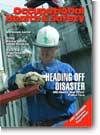
March 2005
Features
By Linda F. Johnson, MS, CSP
FEW workplace injuries leave more noticeable scars and jagged reminders than head/face injuries. Scarring, burns, pitted or uneven skin texture, severe sunburn or frostbite damage, or disfiguring skin pigmentation changes can be forever present after an injury to the face or head.
By Charley Bryant
IN bridge-building environments where natural foot-level anchorage points exist, contractors and inspectors can look at installing horizontal lifeline systems for their means of fall protection.
By Bill Sokol
ACCORDING to OSHA 1910.95(b)(1), when harmful workplace noise cannot be controlled by other means, "personal protective equipment shall be provided and used . . . ." This may seem like an easy task, but it's not. With a plethora of product options available and new technologies offering improved capabilities, safety professionals are often at a loss to understand which product is best in which application.
By W. Jon Wallace, CSP, MBA
FLAMMABLE and combustible liquids are present in nearly every workplace. Gasoline, diesel fuel, and many common products such as solvents, thinners, cleaners, adhesives, paints, and polishes may be flammable or combustible.
By Kris Bancroft
FOR some years now, there has been a debate over whether it is safer to leave a portable oxy-fuel welding and cutting unit in a constant state of readiness for use, or whether the unit should be disassembled when it will not be used for "X" period of time.
By Jerry Laws
Editor's note: Private and public organizations can use NFPA 1600, Standard on Disaster/Emergency Management and Business Continuity Programs, to set up effective programs for mitigation, preparation, response, and recovery from disasters and emergencies. NFPA (www.nfpa.org) has made the 2004 edition of the standard freely available on its Web site to allow for widespread use.
By Fred Elliott
THE basics of heat stress are well known, as are the ways to prevent it from becoming a problem. That anyone remains at risk of heat-related serious illness, or worse, is a sign that the dangers have been forgotten or simply are being ignored.
By Chris Rutter
IN June 2001, a Marietta, Ga., worker was using his feet to tamp down cardboard inside a compactor when his feet became caught in the cardboard and he was pinned inside the machine.
Departments
By Ronnie Rittenberry
LIFE is full of surprises. They can either take our breath away with delight or, well, just take our breath away . . . permanently.
By Jerry Laws
ERGONOMICS isn't dead. Reports of its death at the hands of Congress and the president four years ago were exaggerated--by me and many other observers.
By Doug Silsbee
MOST people agree coaching is an essential part of managing and leading people, but doing so can be fraught with difficulties. The authority of the coach/boss over the employee and the potential for the supervisor's interests to differ from the individuals' interests are critical factors to consider.